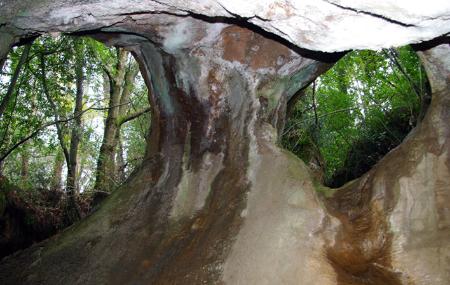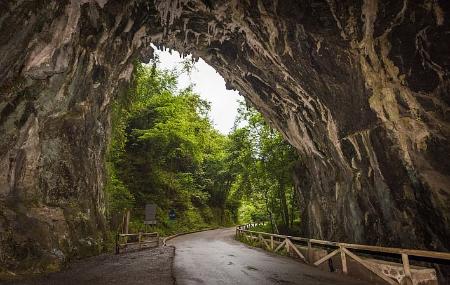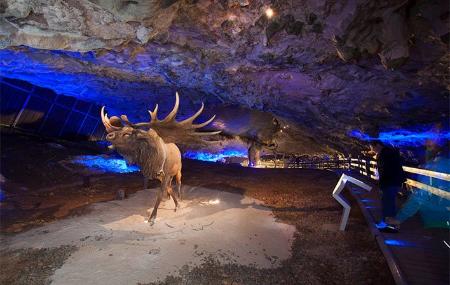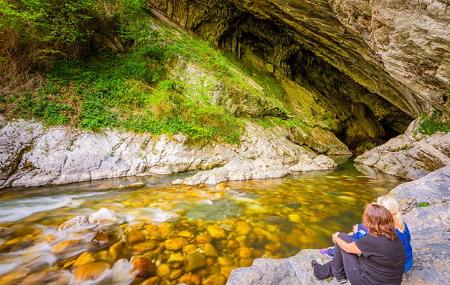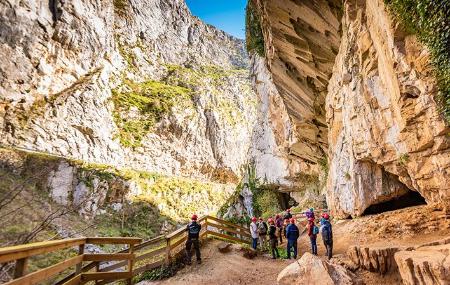Due to its karst nature, Asturias is a true paradise for the discovery of natural caves and grottoes, whose unique habitat - both geologically and in terms of the surrounding flora and fauna - makes them ideal places to experience sensations in the natural environment.
Natural caves, a great tourist attraction
Asturias is a dream destination for explorers, because its natural morphology and physical geography offer a multitude of caves, grottoes and shelters where you can enjoy nature and its many forms and scenic manifestations. Caves are places to discover unique ecosystems, both for their geological formations and for the living organisms (flora and fauna) that inhabit them, some of which date back to prehistoric times.
For all these reasons, Asturias is an ideal place to enjoy cave tourism.
Natural caves that can be visited
There are many natural caves to visit in Asturias. Here we suggest six that, due to their geological beauty, their original landscape, their animal and plant inhabitants and their history, will have a special fascination for your travelling spirit.
/documents/39908/9447969/cueva-avin.jpg/0f62b90a-27d0-760e-856e-fc3d9f6b5066?t=1723458427560

Cave of Avín (Onís). ©Juanjo Arrojo.
Avín Cave
In the heart of the Picos de Europa, at the entrance to the village of Avín in Benia (Onís), we find the Cuevona de Avín, dedicated to the dissemination of life in the glacial period, some 40,000 years ago.
To visit the cave, you must go to the Glacial Fauna Interpretation Centre. There you will find a 500-metre route through this large cave where, as well as being a natural attraction, you will find life-size reproductions of the now extinct megafauna that inhabited the area during the Pleistocene, such as mammoths, woolly rhinoceroses and megaloceroses, a species of giant deer.
In the nearby cave of La Peruyal you can visit the complete fossil skeleton of a prairie rhinoceros calf, which is of great interest as it is perfectly preserved.
The cave of Avín is a large cave with high ceilings through which a river flows. The visit takes place on raised wooden platforms, making it wheelchair accessible.
/documents/39908/9447969/cueva-deboyo.jpg/903a8673-ebbd-c1fe-8eb0-0c1a188ad068?t=1723458428899

Deboyu Cave (Caso). ©Ignacio Terán.
Deboyu Cave
Deboyu Cave is a Natural Monument of the Principality of Asturias. It is a cave of karstic origin through which the river Nalón flows. The river literally disappears under the mountain, near Les Llanes, and reappears some 200 metres further down. In reality, this is a rare phenomenon.
It is even more interesting because it is where most of the bats in the Redes Natural Park live, such as the Mediterranean horseshoe bat, the river bank bat and, to a lesser extent, the big horseshoe bat, the dwarf bat and the cave bat.
Don't try to get in: it's rather dangerous. But the gentle and serene flow of the river here is very soothing, which makes Deboyu Cave a place of particular charm.
Getting there is easy: When you go up the AS-117 from just before reaching El Campu you have to go through two tunnels, because just before the second tunnel there is a turn-off to the right. This is the one signposted "Cueva Devoyu". There is a recreational area with tables, ideal for a family outing.
/documents/39908/9447969/cueva-huerta.jpg/fdce68af-8a68-932f-0eda-5746484149a0?t=1723458430394
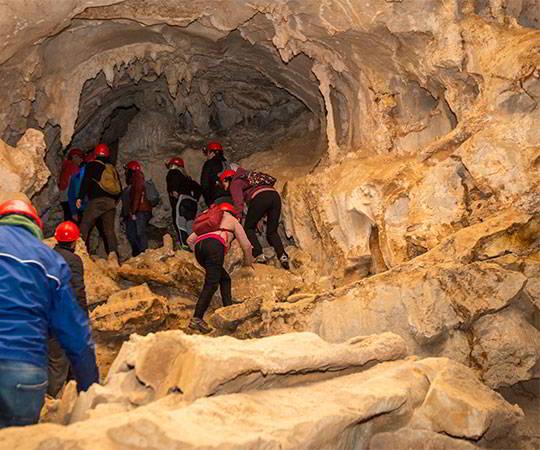
Huerta Cave (Teverga). ©Mampiris.
Huerta Cave
In the Estrechura Gorge, just a few kilometres from the Teverga Prehistoric Park, is the Huerta Cave. Declared a Natural Monument in 2002, this impressive cave is one of the largest in Asturias, with a length of 14.5 kilometres. Its remarkable geomorphological, speleological and natural value makes it a place of great interest for scientists and caving enthusiasts.
Cueva Huerta is home to colonies of bats of the species Miniopterus schreibersii, which are in danger of extinction. This species uses the cave as a shelter during the winter, so its conservation is crucial for its survival.
The cave is divided into 3 levels: the lower level is flooded, the intermediate level has water flow at certain times of the year and it is on the upper level where most of the activity in the cave and the area that can be visited takes place.
/documents/39908/9447969/interior-cueva-huerta.jpg/dadfc8d2-f203-81c5-e482-372a08720364?t=1725016053234
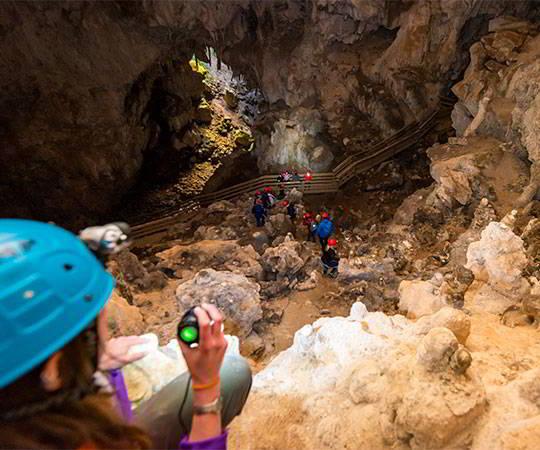
Huerta Cave (Teverga). ©Mampiris.
Visiting Cueva Huerta is a perfect plan, with friends or family. The guided tour takes place on a wooden walkway with an approximate distance of 300 metres, and is suitable for everyone. The only difficulty is going up and down stairs. No special footwear or clothing is required, just comfortable shoes that allow you to move around. The company offering the activity provides you with a helmet and lamp.
It is now possible to extend the visit with an introductory caving course, which consists of accessing another small room for abseiling and caving. If the conditions allow it, the river bed can be followed and the springs where the river rises again can be visited.
/documents/39908/9447969/cueva-andina.jpg/fbc4c6fb-196c-c0b0-ff2f-212e7f36b342?t=1723458425896

Caves of Andina (El Franco). ©Juan de Tury.
Andina Caves
In the village of Andía, belonging to the council of El Franco, in western Asturias, are the Andina Caves, declared a Natural Monument in 2002.
The Andina Caves are located in a semi-enclosed valley of limestone rock and are of great archaeological importance, a key to understanding the morphology of the area. A large part of the site is the result of mining activities carried out by the Romans to extract gold. Over time, the rocky outcrops have been covered with abundant vegetation and woodland, so that the cave is practically unnoticed from the outside.
The cave is crossed by a stream that flows into the river Mazo and is a site of geological interest that is of great natural beauty, combining whimsical rock formations with the exuberant and colonising greenery of Asturian nature.
/documents/39908/9447969/cuevona-cueves.jpg/03422b4d-ecab-56ff-08cf-558cf331bb74?t=1723458433219

Cueves Cave (Ribadesella). ©Mampiris.
Cueves Cave
The Cuevona de Cueves is the most different from the rest of this list in that it is the only entrance to the village of Cueves. It is perfectly lit and can be crossed by car or on foot.
It is 300 metres long and contains extravagant limestone formations, such as stalagmites, lava flows, columns and stalactites that attract the attention of everyone who passes by. The Cuevas stream and the erosion it has caused over thousands of years is one of the main culprits in the formation of the cave. Mosses, lichens, fungi, ferns and algae are scattered throughout the cave, the anteroom to the beautiful and hidden village of Cueves.
Tips for visiting the caves of Asturias
- Find out about the cave and its surroundingsbeforehand to make the most of your visit.
- Check the environmental conditions, such as temperature, length of the route, humid areas and the existence of stairs.
- Wear appropriate clothing and footwear; you may need a warm jacket due to the change in temperature inside some caves. Carry a light backpack with the essentials, leaving your hands free.
- Always follow the guide's directions and stay on marked trails.
- Avoid touching natural formations and keep a respectful tone of voice.
- Pay attention to low ceilings and slippery areas to avoid accidents.
- Do not leave rubbish in the cave and remove everything you carry with you.
- Ask about taking photos and whether you can use flash.
- Use the toilet and your mobile phone before entering, as there will be no reception or services inside.
- Remember that some caves do not allow access with backpacks, food or drink.
Visit the natural caves
Asturias is, by nature, a true paradise of natural caves. It is highly recommended to visit them, to enjoy a healthy immersion in authentic wonders of a landscape that permanently invites you to explore.

